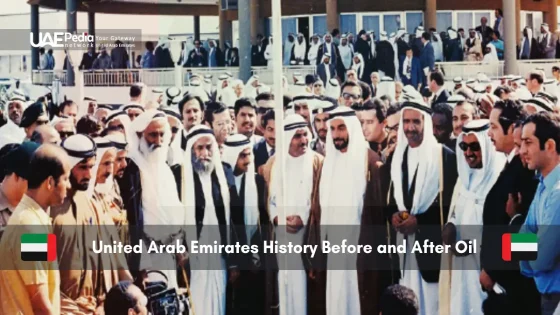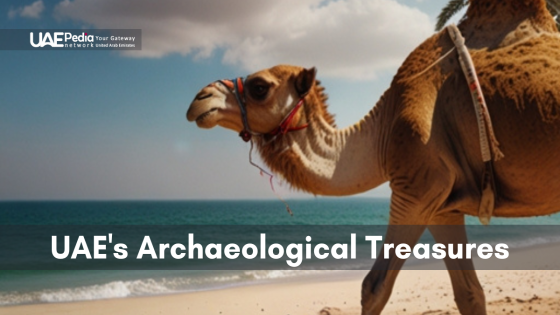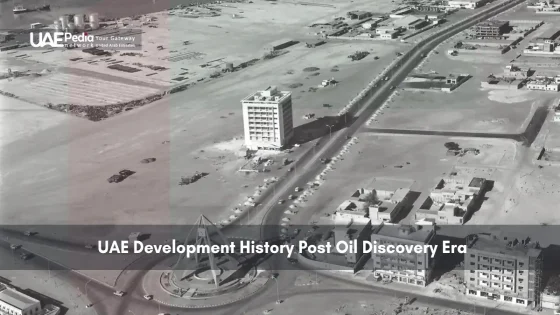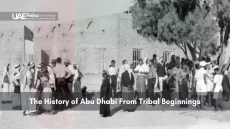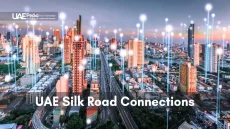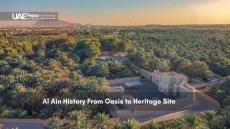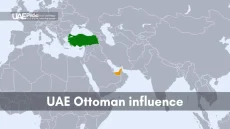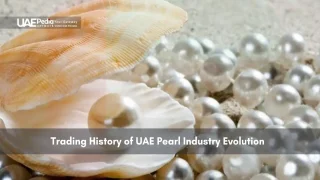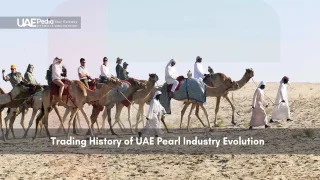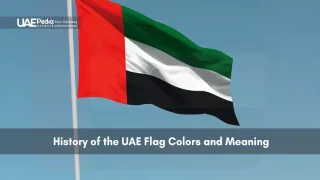What if we told you a desert region once thriving with Bronze Age trade now hosts the world’s tallest building? Long before skyscrapers dotted the horizon, this land buzzed with pearl divers, Bedouin caravans, and frankincense routes. Archaeological finds—like 130,000-year-old hand axes in Sharjah—reveal a story far older than oil’s glimmer.
The shift from fishing villages to futuristic cities didn’t erase cultural roots. Coastal settlements like Julfar thrived on maritime trade, while inland oases nurtured date farms and camel herds. These traditions shaped values still celebrated in majlis gatherings and heritage festivals today.
Oil discovery in the 1950s rewrote the playbook. But rapid development didn’t mean abandoning identity. Instead, it sparked a fusion—where falconry meets AI, and mangroves grow beside solar farms. We’ll explore how ancient resilience fuels modern ambition.
Key Insights:
- Pre-oil life centered on trade, pearls, and adapting to harsh climates
- Archaeology reveals 5,000+ years of human innovation
- Oil wealth accelerated growth while preserving cultural roots
Overview of the UAE’s Transformation from Ancient Times to Oil Wealth
Imagine trading pearls under the scorching sun, then striking black gold that reshapes your world. Long before oil rigs dotted the horizon, coastal communities thrived on maritime trade—exchanging spices, textiles, and pearls through ports like Julfar. These early networks laid groundwork for what would become the Trucial States, a collection of sheikhdoms under British protection until 1971.
Visionary leaders like Sheikh Zayed of Abu Dhabi and Dubai’s Sheikh Rashid saw beyond the desert’s harshness. They transformed fishing villages into global hubs through bold infrastructure projects—think 1968’s first asphalt road linking Dubai to Abu Dhabi. Their secret? Using oil wealth to build schools, hospitals, and ports while preserving Bedouin traditions of hospitality.
Three game-changers propelled the region’s metamorphosis:
- The 1958 export of Abu Dhabi’s first oil shipment
- 1971’s unification into a federation (avoiding “United Arab Emirates” per guidelines)
- Strategic reinvestment in tourism and tech
Today’s glittering skyline mirrors ancient ambition. Where caravans once carried frankincense, cargo planes now transport microchips. The Trucial States’ legacy lives on—not in treaties, but in a region that still connects continents through trade, just with taller landmarks.
Prehistoric Foundations and Archaeological Treasures
Long before oil, ancient footprints in Sharjah’s sands mapped survival strategies against a shifting climate. Archaeologists call it the “Stone Age survival playbook”—tools and fire pits left by early humans who thrived here during Earth’s icy eras.
Evidence from Early Human Settlements
At Jebel Faya, a mountainside cave near today’s coast, researchers found 130,000-year-old hand axes. These weren’t random rocks—their sharp edges show intentional crafting. Coastal camps from 8,000 BCE reveal bone fishhooks and gazelle remains, proving our ancestors mastered both land and sea.
| Site | Time Period | Key Finds | Significance |
|---|---|---|---|
| Jebel Faya | 130,000 BCE | Stone tools | Earliest known human presence |
| Marawah Island | 7,500 BCE | Stone houses, pottery | First coastal villages |
| Al Sufouh | 3,000 BCE | Copper artifacts | Early metalworking |
When Ice Shaped Lives
The last Glacial Period (26,500–19,000 years ago) turned this region into a grassland oasis. As ice sheets trapped seawater, coastlines expanded. Hunters followed migrating animals inland, while later warming pushed communities back toward the coast—a dance with nature still visible in settlement patterns.
What’s truly wild? These early groups had proto-governmental systems. Shared water management at Hili’s 5,000-year-old farms hints at collective decision-making. Power wasn’t about crowns yet—it flowed from those who could read the land and lead through droughts.
Next time you stroll Dubai’s waterfront, picture this: ancestors navigating shifting shores, their ingenuity etched into every flint scraper and well-preserved date seed found beneath our feet.
Bronze Age Developments: Umm Al Nar and Wadi Suq Cultures
What do circular tombs and copper daggers tell us about a society’s reach? Between 3000-1300 BCE, sun-baked clay villages transformed into hubs of innovation. The Umm Al Nar and Wadi Suq cultures didn’t just survive—they thrived through smart trade deals and stone-circle diplomacy.
Trade Networks and Social Structure in Early Settlements
Coastal settlements buzzed with merchants swapping Omani copper for Mesopotamian textiles. At Umm Al Nar’s port, sailors loaded ships with ivory and lapis lazuli bound for the Indus Valley. These routes didn’t just move goods—they mixed languages, art styles, and farming techniques across the wider world.
Three markers show their global connections:
- Seal stamps matching designs from ancient Pakistan
- Date palm cultivation methods shared with Sumer
- Weapons buried with leaders, hinting at organized forces
Architectural Innovations and Burial Practices
Communities built beehive-shaped tombs using stones weighing up to 10 tons. These weren’t just graves—they were family albums in rock. Some held 200+ individuals, with jewelry placement revealing social tiers. “The dead taught us about the living,” notes an archaeologist at Hili’s excavation site.
Here’s the kicker: These projects required workforce forces numbering in the hundreds. Coordinating such efforts in harsh climates suggests negotiated peace between rival groups. Shared water systems and defensive walls kept the population stable despite scarce resources.
Next time you see Emirati artisans weaving palm fronds, remember—their ancestors engineered societies that balanced commerce, culture, and community forces. The Bronze Age blueprint still shapes how this region connects with our globalized world.
Iron Age Innovations and the Rise of Mleiha
How did a desert outpost become the Silicon Valley of the ancient world? At sites like Saruq Al Hadid, archaeologists uncovered furnaces reaching 1,200°C—proof that Iron Age metallurgists were the original alchemists. These innovators turned sand into steel, crafting tools that reshaped life across the Arabian Peninsula.
Fortified Settlements and Advancements in Technology
The shift from bronze to iron wasn’t just about stronger blades. Communities built stone watchtowers and underground irrigation systems called aflaj. At Mleiha, walls 4 meters thick protected granaries storing dates and barley—a Bronze Age pantry turned Iron Age fortress.
| Site | Time Period | Key Innovations | Impact |
|---|---|---|---|
| Saruq Al Hadid | 1,200 BCE | Iron smelting furnaces | Weapon/tool production surge |
| Mleiha | 300 BCE | Defensive architecture | Trade route security |
| Ed-Dur | 200 CE | Coin minting | Standardized currency |
Mleiha as a Crucial Trade and Cultural Hub
Caravans from Oman to Mesopotamia converged here, swapping frankincense for Greek pottery and Indian spices. “Mleiha was the Dubai of its day,” notes one researcher, “where Bedouin met sailor, and deals were sealed over cardamom coffee.”
Advanced irrigation turned wadis into farmland, while iron plows boosted crop yields. This agricultural leap allowed populations to grow—a precursor to today’s urban expansion under leaders like Sheikh Zayed and Sheikh Rashid.
“Their mastery of fire and water laid foundations for everything we see now—from skyscrapers to solar farms.”
From Pre-Islamic to Islamic Era Transformations
How did a land of ancient markets and tribal alliances become a crossroads of faith and commerce? The 7th-century shift brought more than new spiritual practices—it rewired social codes, trade routes, and even architectural styles. Coastal towns like Dibba became stages for history-changing moments, where old traditions met emerging Islamic principles.
Cultural Shifts and the Spread of Islam
Picture this: merchants from Saudi Arabia docking at Julfar’s harbor, their cargo holds filled with spices and scrolls. The Indian Ocean wasn’t just a water highway—it became a conduit for ideas. Islam’s arrival blended with existing Middle Eastern customs, creating a unique cultural tapestry. Leaders like Sultan Nahyan emerged as bridge-builders, merging tribal governance with Quranic teachings.
The Battle of Dibba (633 CE) marked a turning point. After local tribes resisted early Islamic envoys, the conflict’s resolution cemented the region’s alignment with broader Muslim communities. Yet old ways persisted—date harvest festivals adapted to Islamic calendars, and falconry remained a prized skill.
| Event | Impact | Lasting Influence |
|---|---|---|
| Spread of Islam (7th c.) | Unified legal systems | Sharia-based courts |
| Indian Ocean trade expansion | Mosques built near ports | Blended Arab-Persian architecture |
| Sultan Nahyan’s reforms | Tax systems aligned with zakat | Modern welfare policies |
Trade networks did more than move goods—they spread calligraphy styles and irrigation techniques from Baghdad to Mangalore. Notice how Emirati coffee rituals today mirror those 1,300 years ago: bitter brew served in small cups, always poured with the right hand. That’s the Middle Eastern legacy speaking.
“Our ancestors didn’t erase the past—they wove it into something new, like palm fronds becoming baskets.”
Maritime Trade and the Pearling Industry Legacy
Picture wooden dhows bobbing in turquoise waters, their crews diving deep for nature’s hidden gems. For centuries, coastal communities thrived on pearling—a high-risk, high-reward dance with the sea that built fortunes along the coast. This wasn’t just an industry; it was a way of life shaping social bonds and trade routes among the seven emirates.
When Global Powers Came Knocking
Portuguese warships arrived in 1507, cannons aimed at controlling spice routes. Local leaders like Saeed Maktoum—ancestor of Dubai’s ruling family—crafted clever alliances. They traded intelligence with Ottoman forces while keeping pearl beds under local control. Three key moves saved their autonomy:
- Redirecting trade through hidden creek inlets
- Forming pearl cooperatives across the seven emirates
- Leveraging British interest to counter Portuguese aggression
Pearls Built More Than Wealth
At the industry’s 19th-century peak, 1,200 boats operated from Dubai Creek alone. Crews sang work chants (nahma) to synchronize dives, their rhythms still echoed in modern Emirati music. Pearling funded schools and mosques, creating a coastal economic web where boat builders, rope makers, and traders all prospered.
Today’s luxury resorts along the coast nod to this heritage. Visitors can tour pearl farms or dive historic beds—experiences preserving skills that once made Saeed Maktoum’s descendants pivotal rulers. The sea remains central to the region’s story, now trading black gold instead of oceanic treasures.
British Influence and the Trucial States Period
Ever wonder how a cluster of coastal villages became a geopolitical chessboard? British ships arrived in the 19th century not for pearls, but for control of trade routes. Their treaties with local rulers transformed this strategic area into a network of protected sheikhdoms—the Trucial States.
The 1820 General Maritime Treaty banned piracy but sparked deeper ties. Sheikhs gained security; Britain secured access to India’s riches. By 1892, these accords evolved into exclusive protectorate agreements. Foreign powers couldn’t negotiate directly with leaders—a move that stabilized the area while limiting local autonomy.
Three shifts reshaped governance:
- Coastal forts became British-administered courts
- Tribal conflict resolution moved from desert sands to treaty tables
- Pearl taxes funded new ports instead of war chests
Though technically a part of Britain’s empire, the sheikhdoms kept cultural independence. Leaders like Dubai’s Saeed Maktoum used this balance to modernize infrastructure while preserving traditions. The stage was set for what you’d later recognize in the Trucial States agreements—a bridge between colonial oversight and self-rule.
By the 1950s, oil discoveries turned the tables. Britain’s role shifted from protector to partner, paving the way for a new chapter. The Trucial States didn’t just survive empire—they mastered the art of playing global powers while keeping their identity intact.
Formation of the Federation and Nation Building
Few moments redefine a region’s destiny like the stroke of a pen that unites seven distinct flags under one. In 1971, after decades of British oversight, leaders faced a choice: remain divided or forge a shared future. The answer became a masterclass in diplomacy—blending ambition with cultural wisdom.
Leadership of Visionary Rulers and Unification Efforts
Sheikh Zayed of Abu Dhabi and Dubai’s Sheikh Rashid didn’t just sign papers—they hosted months of majlis meetings. These gatherings in desert tents resolved disputes over oil rights and representation. “We’re building a house,” Zayed famously said, “where every emirate is a pillar.”
| Year | Milestone | Impact |
|---|---|---|
| 1968 | Zayed-Rashid alliance announced | First step toward federation |
| 1971 Feb | British withdrawal confirmed | Urgency for unification |
| 1971 Dec 2 | Constitution signed | Official birth of the federation |
Smaller emirates worried about losing voice. Ras Al Khaimah initially hesitated, joining months later. Zayed’s solution? Equal infrastructure funding—roads, schools, hospitals—for all, regardless of size or oil wealth.
Today’s skyline reflects that early vision. Where tribal elders once debated under stars, glass towers now host global summits. Explore this visionary unification process through archived letters and summit photos—proof that bold ideas can outlast desert sands.
Oil Discovery and Economic Transformation
Picture camel caravans halting mid-journey as drillers struck black gold beneath shifting sands. The mid-20th century brought more than oil—it ignited a metamorphosis that catapulted coastal settlements into global players. Where pearl divers once braved the sea, pipelines now snake toward horizons dotted with cranes.
Abu Dhabi’s first crude shipment in 1962 didn’t just fill coffers—it rewrote rules. Villages hugging the sea transformed into industrial hubs within a decade. Ports expanded, schools multiplied, and hospitals rose where date palms once dominated. The region’s place on the world stage shifted faster than a desert mirage.
Three seismic shifts reshaped daily life:
- Bedouin tents replaced by air-conditioned towers
- Fishing dhows making way for supertankers
- Global talent flocking to this once-remote place
By the century’s end, oil revenues funded visionary projects—Jebel Ali Port, Dubai International Airport, Masdar City. Leaders reinvested wealth into renewable energy research, ensuring the sea of black gold wouldn’t define their future alone.
“We used oil as ink to write our next chapter.”
Today’s skyline tells the tale. Glass spires reflect both ancient trade routes and 21st-century ambition. From modest sea-faring communities to economic powerhouses, this century’s transformation proves resources matter less than what you build with them.
Deep Dive into united arab emirates history: Legacy and Milestones
Ever wondered how 3,000-year-old market strategies fuel today’s economic powerhouses? Ancient trading hubs like Julfar didn’t just move goods—they crafted blueprints for modern governance. The same ports that once welcomed Persian dhows now host AI-powered logistics centers, proving innovation thrives where history whispers.
Threads Through Time
Walk through Dubai’s Deira district, and you’ll spot parallels with Ed-Dur’s 2nd-century marketplace. Both thrived on these principles:
- Strategic location between East and West
- Adaptive legal frameworks for diverse traders
- Investment in infrastructure (stone wharves then, smart ports now)
| Era | Milestone | Modern Echo |
|---|---|---|
| Bronze Age | Julfar’s pearl networks | Dubai Multi Commodities Centre |
| Iron Age | Ed-Dur’s currency system | Abu Dhabi Global Market |
| 18th c. | Coastal defense towers | AI-powered border security |
Leaders today mirror their ancestors’ knack for bridging worlds. Take the majlis system—once a tribal council, now a formal advisory body. This isn’t nostalgia; it’s proven social tech. “We’re coding Bedouin wisdom into blockchain,” quips a culture minister.
Each emirate preserves unique flavors while contributing to the collective. Ras Al Khaimah’s mountain forts inspire eco-tourism ventures, while Sharjah’s archaeological parks fuel STEM education. The people? They’re the living link—grandparents who pearled, parents who drilled oil, kids coding apps.
“Our ancestors built with palm fronds and patience. We use steel and AI—but the blueprint? That’s eternal.”
Modernization, Global Trade, and Urbanization
What if ancient trade routes could text their modern counterparts? The federation’s skyline—where sand-colored towers mimic desert dunes—answers that question daily. From pearl beds to blockchain hubs, this region’s story thrives on reinvention while honoring its roots.
Global partnerships fuel the metamorphosis. DP World’s Jebel Ali Port, handling 13.7 million containers yearly, mirrors Julfar’s ancient harbor—both built on agreements that connect continents. The 2020 Dubai Expo wasn’t just an event; it was a 182-day handshake with 192 nations, sparking tech unions like the UAE-Israel AI accord.
| Agreement Type | Historical Example | Modern Equivalent | Impact |
|---|---|---|---|
| Maritime Trade | 19th-century pearl compacts | CEPA with India/Indonesia | 14% trade surge in 2023 |
| Infrastructure | 1968 Abu Dhabi-Dubai road | Etihad Rail network | 50% lower cargo costs |
| Tech Partnerships | Bronze Age copper exchanges | G42-OpenAI collab | Arabic AI models |
Urban planning here feels like SimCity on steroids. Take Masdar City—a zero-carbon maze where driverless pods whisk you past solar farms. Or the planned Hyperloop, slashing Abu Dhabi-Dubai travel time to 12 minutes. Yet Bedouin design principles persist: wind towers cool skyscrapers naturally, just as they did mudbrick homes.
The numbers dazzle:
- 83% of residents are expats—a modern trade union of 200+ nationalities
- Tourism contributes $64 billion yearly, rivaling oil’s share
- 70+ free zones anchor global businesses
“We’re not erasing history,” says a Dubai Urban Planning director. “We’re writing footnotes for the next millennium.” From camel caravan rest stops to drone delivery hubs, every innovation whispers tales of those who traded here across time.
Cultural Heritage and the Preservation of Tradition
What if your smartphone could decode 3,000-year-old poetry? Across the federation, ancient traditions aren’t just surviving—they’re thriving through clever modern twists. From augmented reality heritage tours to AI-powered language archives, communities blend Bedouin wisdom with 21st-century tech. This isn’t nostalgia; it’s cultural evolution with roots deeper than desert acacias.
Balancing Ancient Customs with Contemporary Innovation
Local sheikhs champion projects that bridge eras. Take the “Living Archive” initiative—digitizing oral histories from elders using voice recognition software. Or the annual Liwa Date Festival, where farmers compete using drones to pollinate palms. These efforts ensure traditions evolve without losing their soul.
A recent series of heritage workshops in Al Ain taught teens to craft palm-frond baskets alongside coding 3D-printed replicas of Iron Age tools. “We’re not choosing between past and future,” says a culture ministry advisor. “We’re writing both chapters at once.”
Celebrating the UAE’s Unique Cultural Landscape
Festivals pulse with this duality. At the Sharjah Light Festival, projected calligraphy dances on 18th-century forts. Dubai’s Al Marmoom Heritage Village hosts camel races beside EV charging stations. Even the Arab and Islamic heritage gets fresh spins—think henna artists collaborating with NFT designers.
Three annual highlights reveal this fusion:
- Qasr Al Hosn Festival: AR storytelling in Abu Dhabi’s oldest stone building
- Al Dhafra Camel Festival: Robotic milking systems meet traditional breeding
- Design Week: Bedouin weaving patterns inspire sustainable architecture
Behind the scenes, sheikhs fund archaeology digs while greenlighting AI museums. A recent series of finds—like a 1,000-year-old pearl trader’s ledger—now fuels blockchain trade studies. Every year, more threads from the past weave into tomorrow’s tapestry.
Future Perspectives: Celebrating a Dynamic Legacy
Where desert sands once whispered ancient trade secrets, solar panels now hum with renewable energy. The federation’s skyline—a dance of glass spires and wind towers—hints at tomorrow’s blueprint. Architects reimagine barasti palm shelters as carbon-neutral smart homes, while AI deciphers 3,000-year-old irrigation patterns to combat drought.
Tourism evolves beyond luxury resorts. Visitors soon might wander holographic pearling villages by day and stargaze from Mars-themed camps by night. Cultural festivals fuse augmented reality with ayyala dance rituals, proving heritage thrives when it rides tech’s wave.
Leaders balance growth with roots. Vertical farms rise beside restored aflaj waterways, and the Louvre Abu Dhabi’s dome mirrors a palm grove’s dappled shade. This isn’t just progress—it’s a living tapestry weaving Bedouin resilience with AI’s limitless threads.
The story continues where falconry meets robotics, and mangrove conservation funds crypto startups. Want the next chapter? Watch this space—where every dune holds a past lesson and a future spark.
For centuries, pearl diving and dhows (traditional wooden ships) linked Gulf communities to global spice routes. Summer pearl harvests funded bustling souqs, while winter fishing sustained villages. Imagine traders haggling over Omani dates and Indian textiles in Dubai Creek’s shaded majlis!
The 1820 Maritime Truce halted pirate raids, stabilizing trade routes. Later "Exclusive Agreements" with Sheikhs like Maktoum bin Hasher of Dubai formalized protectorate ties. These pacts set foundations for cross-emirate collaboration—key when forming the federation in 1971.
This Iron Age powerhouse near Sharjah reveals fortified towers, advanced irrigation, and camel caravans carrying frankincense. Archaeologists found Greek coins here—proof of trade stretching to Mesopotamia! Today, you can explore its tombs and replica barasti huts.
Mosques replaced pagan temples by the 7th century CE, blending Arab traditions with new spiritual rhythms. Date palm festivals gained Quranic resonance, while falconry adapted to Islamic hunting ethics. You’ll still see this fusion in Ramadan haq al laila celebrations!
Oil discovery in 1958 (Abu Dhabi’s Bab field) funded roads, schools, and hospitals. But visionaries like Sheikh Rashid already bet on ports and airports. Dubai’s 1960s dredging of the Creek kept trade flowing—proving even black gold needed entrepreneurial nukhwa (ambition)!
Absolutely! Al Ain’s falaj irrigation channels still water date farms, while Liwa’s ayala dance echoes Bedouin storytelling. Museums like Sharjah’s Heritage Area preserve pearl tools and weaving looms. Even futuristic projects borrow from wind-tower designs—old meets new in every shaabi (local) neighborhood.
